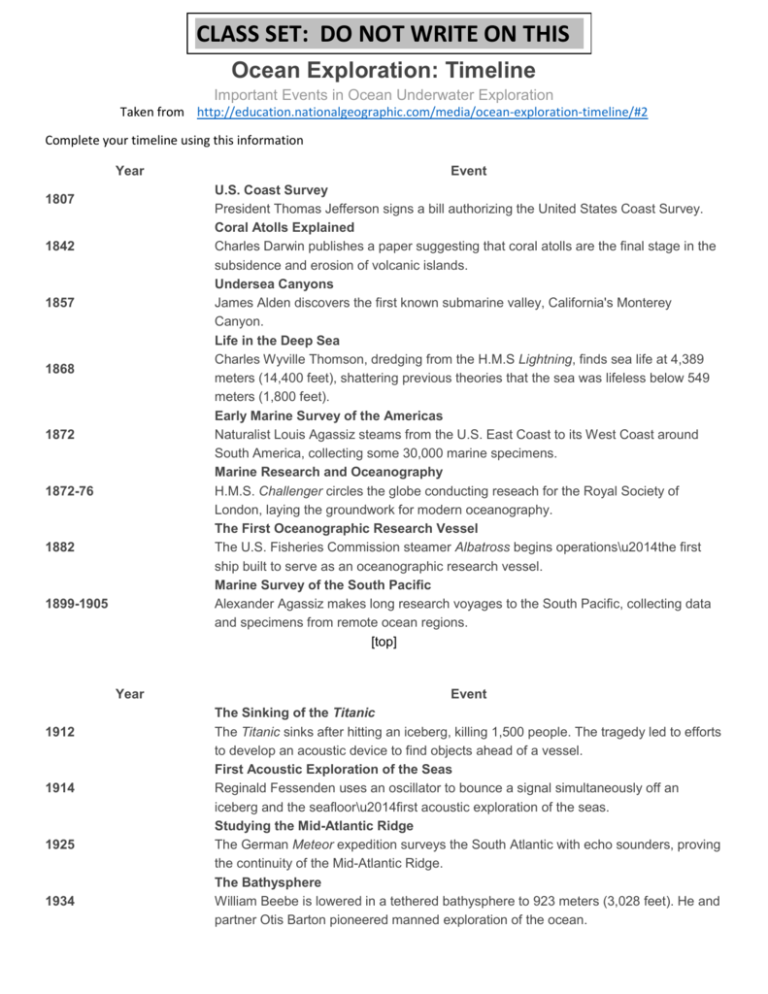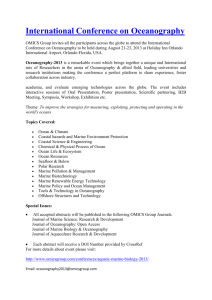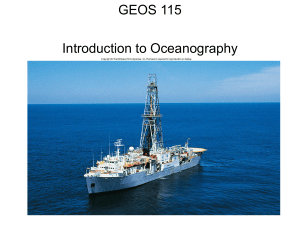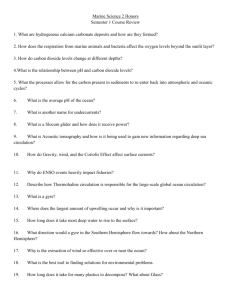File
advertisement

CLASS SET: DO NOT WRITE ON THIS Ocean Exploration: Timeline Important Events in Ocean Underwater Exploration Taken from http://education.nationalgeographic.com/media/ocean-exploration-timeline/#2 Complete your timeline using this information Year Event U.S. Coast Survey President Thomas Jefferson signs a bill authorizing the United States Coast Survey. Coral Atolls Explained Charles Darwin publishes a paper suggesting that coral atolls are the final stage in the subsidence and erosion of volcanic islands. Undersea Canyons James Alden discovers the first known submarine valley, California's Monterey Canyon. Life in the Deep Sea Charles Wyville Thomson, dredging from the H.M.S Lightning, finds sea life at 4,389 meters (14,400 feet), shattering previous theories that the sea was lifeless below 549 meters (1,800 feet). Early Marine Survey of the Americas Naturalist Louis Agassiz steams from the U.S. East Coast to its West Coast around South America, collecting some 30,000 marine specimens. Marine Research and Oceanography H.M.S. Challenger circles the globe conducting reseach for the Royal Society of London, laying the groundwork for modern oceanography. The First Oceanographic Research Vessel The U.S. Fisheries Commission steamer Albatross begins operations\u2014the first ship built to serve as an oceanographic research vessel. Marine Survey of the South Pacific Alexander Agassiz makes long research voyages to the South Pacific, collecting data and specimens from remote ocean regions. [top] Year Event 1807 1842 1857 1868 1872 1872-76 1882 1899-1905 1912 1914 1925 1934 The Sinking of the Titanic The Titanic sinks after hitting an iceberg, killing 1,500 people. The tragedy led to efforts to develop an acoustic device to find objects ahead of a vessel. First Acoustic Exploration of the Seas Reginald Fessenden uses an oscillator to bounce a signal simultaneously off an iceberg and the seafloor\u2014first acoustic exploration of the seas. Studying the Mid-Atlantic Ridge The German Meteor expedition surveys the South Atlantic with echo sounders, proving the continuity of the Mid-Atlantic Ridge. The Bathysphere William Beebe is lowered in a tethered bathysphere to 923 meters (3,028 feet). He and partner Otis Barton pioneered manned exploration of the ocean. Year 1943 Year 1955 1960 1961 1964 1965 1970 Year 1985 Event An Untethered Submersible Dive The French research submersible FNRS-3 descends to 4,041 meters (13,257 feet) off the coast of West Africa, piloted by Georges Houot and Pierre Willm, inaugurating use of manned, untethered, research submersibles. Discovery of Magnetic Striping on Ocean Floor The U.S. Coast and Geodetic Survey ship Pioneer, in a joint project with the U.S. Navy and the Scripps Institution of Oceanography, tows the first marine magnetometer and finds magnetic striping on the seafloor off the West Coast. The discovery adds a key element to the theory of plate tectonics. The Trieste Explores the Mariana Trench The bathyscaphe Trieste dives to what was believed to be the deepest point in the Mariana Trench, recording a depth of 10,912 meters (35,800 feet). Exploring the same area in 1998, a Japanese research vessel measured a depth of 10,938 meters (35,886 feet). Development of the Deep Tow System The Scripps Institution of Oceanography begins development of the Deep Tow System, the forerunner of all remotely operated unmanned oceanographic systems. Submersible Deep Dives The Deep Submergence Vehicle Alvin is constructed by the Woods Hole Oceanographic Institute. Alvin was the first U.S.-based deep-diving submersible, and has now made over 4,400 descents and led to numerous ocean floor discoveries. An Underwater Lab Sealab II, an underwater habitat, is lowered off the coast of California. Sylvia Earle Leads Women Aquanauts Sylvia Earle leads the first team of women aquanauts during the Tektite Project and sets a record for solo diving to a depth of 1,000 meters. [top] 1954 1977 Event The Creation of the Aqua-Lung Jacques Cousteau and \u00c9mile Gagnan modify a demand breathing regulator to engineer the Aqua-Lung\u2014forever changing the course of human interaction with the sea. [top] Event Robert Ballard's Discovery of Hydrothermal Vents Hydrothermal vents are discovered, along with an ecosystem that survives without the energy of the sun, by a team led by Robert Ballard. These ecosystems rely on biota absorbing chemical energy from the venting materials in a process called chemosynthesis. The Discovery of the Sunken Titanic A research team lead by Robert Ballard discovers the Titanic more than 3,810 meters (12,500 feet) down, the most famous shipwreck in modern history. Year 1992 1995 2010 2012 Event Creating Sea Surface Maps TOPEX/Poseidon satellite begins mapping the surface of the sea. Creating Seafloor Maps Declassification of GEOSAT radar altimetry data from a U.S. Navy Earth observation satellite leads to worldwide mapping of the seafloor. Cataloging the Biodiversity of the Ocean The first ever Census of Marine Life catalogs the diversity, abundance, and distribution of marine species collected in an online database. First Successful Solo Dive to the Mariana Trench National Geographic Explorer-in-Residence James Cameron successfully travels to the bottom of the deepest known point in the ocean, Challenger Deep, in the Mariana Trench on the DEEPSEA CHALLENGE expedition. DEEPSEA CHALLENGE is a joint scientific project by James Cameron, the National Geographic Society, and Rolex. This is the first time someone has traveled to this depth since 1960, when the Trieste made its descent, and the first time it has ever been done as a solo mission. [top]







